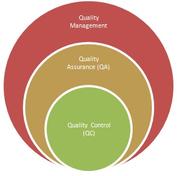
Primary vs. Secondary Transducers: A Detailed Explanation
Understand the difference between primary and secondary transducers in measurement systems, their roles, and examples.

Understand the difference between primary and secondary transducers in measurement systems, their roles, and examples.
Explore the core differences between PXI and PCI bus standards, focusing on their applications in instrumentation and computing.

This article clarifies the distinctions between Quality Assurance (QA) and Quality Control (QC) and their roles within a Quality Management System (QMS).

Explore the distinct functions and applications of radiometers, spectrometers, and spectroradiometers in light measurement.

This article explains the difference between range and span in measurement instruments, using examples like thermometers and spectrum analyzers.
Explore the difference between repeatability and reproducibility in measurements, focusing on the conditions under which readings are taken.

Explore the differences between resistive and capacitive hygrometers, including their working principles and construction.
Explore the fundamental differences between resolution and accuracy in measurements, with clear explanations and examples.
A breakdown of SATA, eSATA, and eSATAp interfaces, detailing their speeds, power capabilities, and use cases.

Explore the Seebeck, Peltier, and Thomson effects, fundamental thermoelectric phenomena underlying thermocouples and other applications.